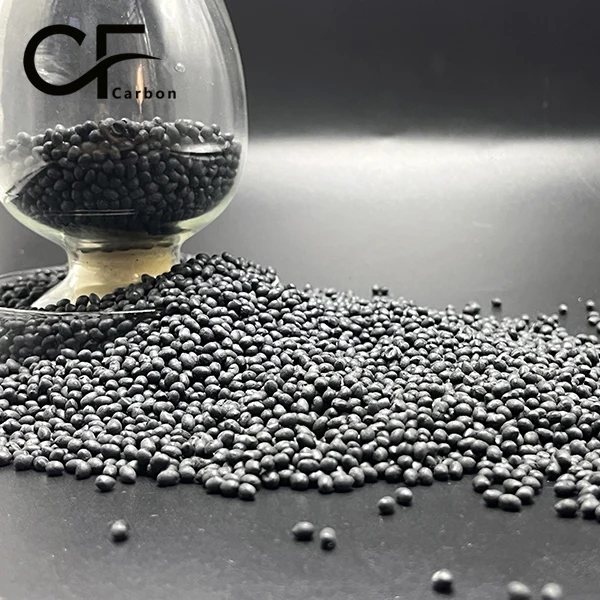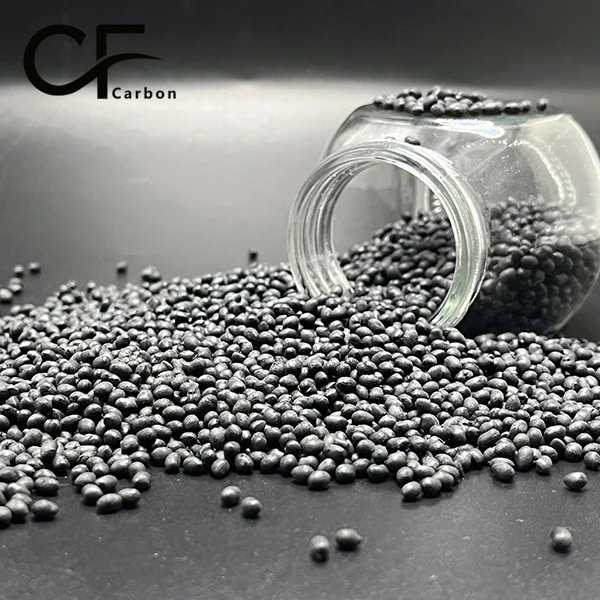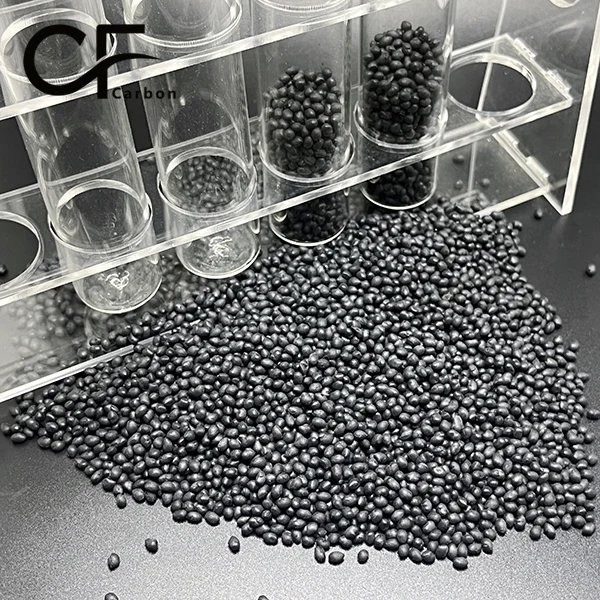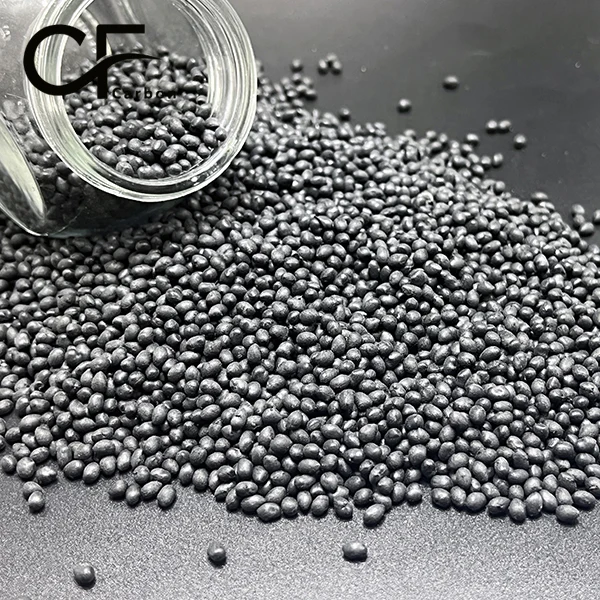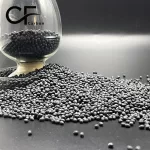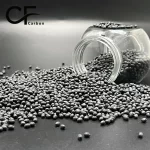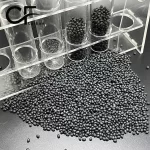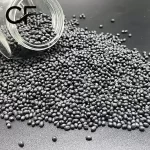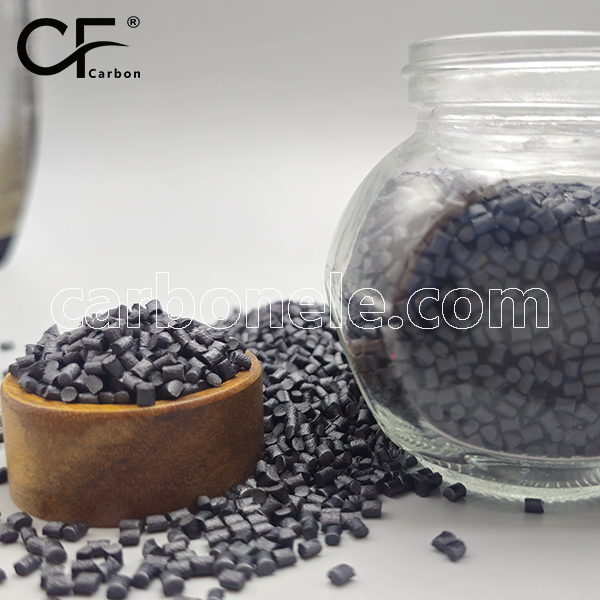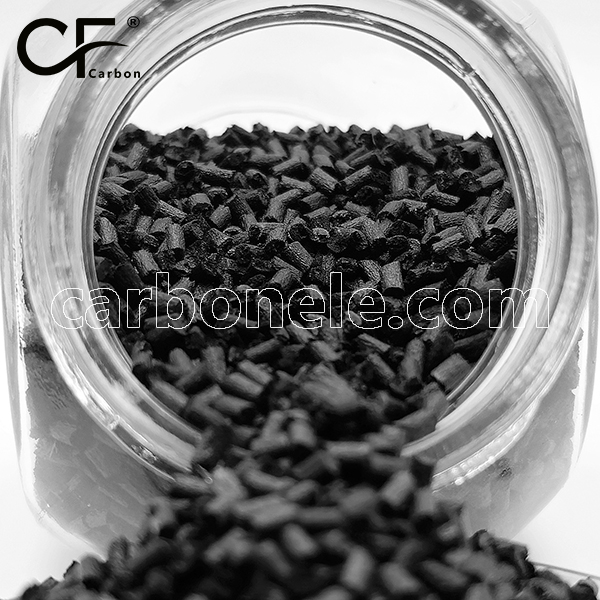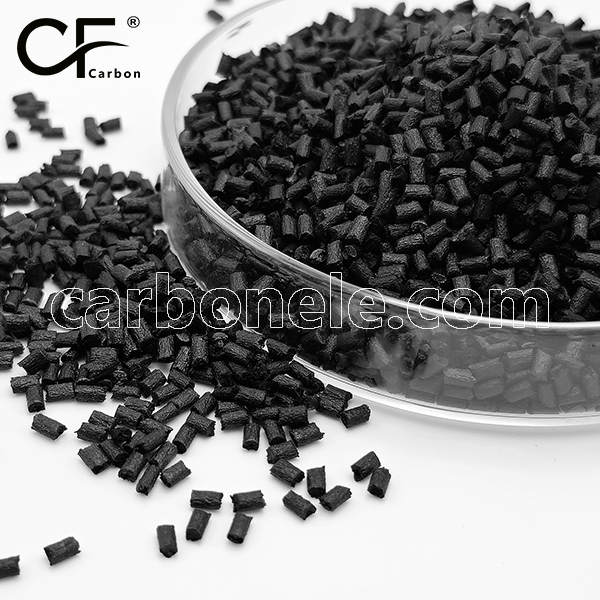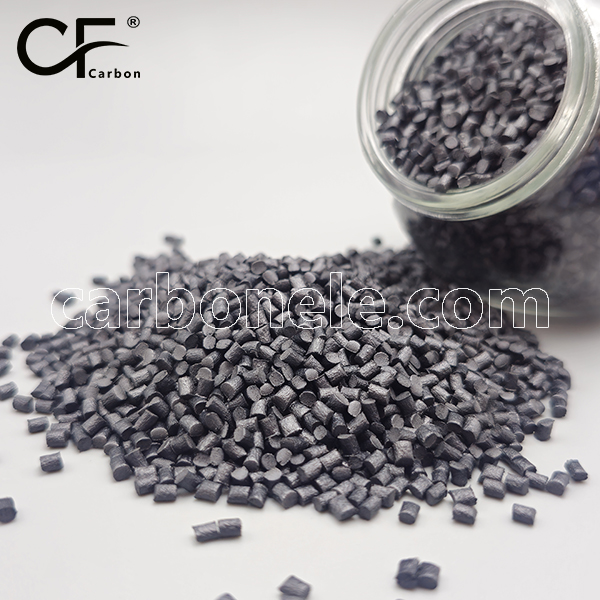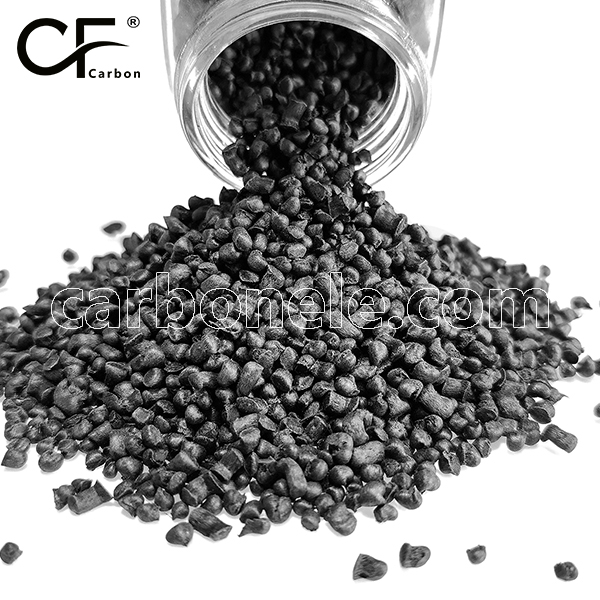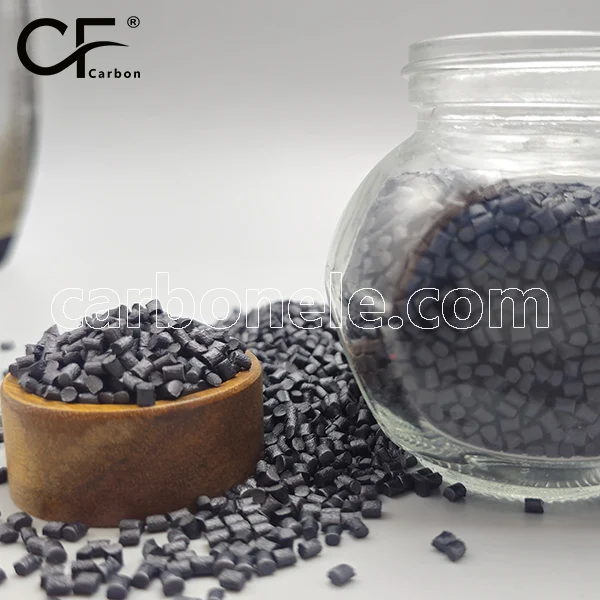
Filament Grade PETG – 10% Carbon Fiber Pellets for FGF 3D Printing
1: Tensile strength reaches 58MPa, 45% higher than pure PETG
2: Flexural modulus is 2800MPa, 2.2x that of pure PETG
3: Heat deflection temperature (1.82MPa) hits 85℃
4: Unnotched Izod impact strength is 8.5kJ/m²
5: Molding shrinkage rate is only 0.8%, lower than pure PETG
- Manufacturer: Carbon New Material
- OEM/ODM: Acceptable
- Color: Black
- Free samples: ≤10kg
- MOQ: 100kg
- Port: Xiamen
- Model: PETG-CF-BCA1
- Fillers: SCF
I. Material Overview
PETG – 10% Carbon is a composite pellet developed specifically for Filament Grade PETG substrates, containing 10% high-modulus carbon fiber and 90% Filament Grade PETG resin. In PETG – 10% Carbon, carbon fiber enhances mechanical properties, while Filament Grade PETG retains impact resistance and processability. The resulting PETG – 10% Carbon Fiber Pellets are compatible with the FGF 3D Printing process, addressing the issue of insufficient strength in pure PETG. PETG – 10% Carbon pellets feature uniform particle size and excellent carbon fiber dispersion, providing stable feeding and molding quality for FGF 3D Printing. PETG – 10% Carbon Fiber Pellets are specialized materials for FGF 3D Printing that balance strength and moldability.
II. Key Material Properties (PETG – 10% Carbon)
1.
Tensile Strength
Printed parts made from PETG – 10% Carbon achieve a tensile strength of 58MPa, a 45% increase compared to pure PETG. After FGF 3D Printing with PETG – 10% Carbon Fiber Pellets, the directional arrangement of fibers further enhances tensile performance, meeting the stress requirements of structural components.
2.
Flexural Modulus
The flexural modulus of PETG – 10% Carbon is 2800MPa, 2.2 times that of pure PETG. The synergistic effect between the Filament Grade PETG substrate and carbon fiber ensures minimal deformation of printed parts from PETG – 10% Carbon Fiber Pellets under stress, making it suitable for FGF 3D Printing of high-precision structural components.
3.
Heat Deflection Temperature
The heat deflection temperature (at 1.82MPa) of PETG – 10% Carbon reaches 85℃, 30℃ higher than pure PETG. Printed parts from PETG – 10% Carbon Fiber Pellets can be used in medium-temperature environments, expanding FGF 3D Printing applications to fields such as automotive interiors.
4.
Impact Strength
The Izod impact strength (unnotched) of PETG – 10% Carbon is 8.5kJ/m², retaining the toughness of Filament Grade PETG and avoiding the brittleness common in carbon fiber-reinforced materials. PETG – 10% Carbon Fiber Pellets are ideal for FGF 3D Printing of impact-resistant enclosures.
5.
Molding Shrinkage Rate
The molding shrinkage rate of PETG – 10% Carbon is only 0.8%, significantly lower than the 1.5% of pure PETG. Printed parts from PETG – 10% Carbon Fiber Pellets via FGF 3D Printing offer high dimensional accuracy, reducing post-processing and improving production efficiency.
III. Main Material Applications
Based on the properties of PETG – 10% Carbon, PETG – 10% Carbon Fiber Pellets are primarily used in the FGF 3D Printing field. In the automotive industry, they are used to manufacture lightweight structural parts such as instrument panel brackets and sensor housings; in the electronics sector, for high-strength connectors and equipment frames; in the drone industry, for fuselage skeletons and propellers; in industrial settings, for custom tooling fixtures and inspection jigs; and in the medical field, for disinfectant-resistant device enclosures. PETG – 10% Carbon balances performance and safety, with the Filament Grade PETG substrate meeting environmental requirements, making PETG – 10% Carbon Fiber Pellets suitable for FGF 3D Printing needs across multiple industries.
IV. Application Case of PETG – 10% Carbon in Drone Fuselage Manufacturing
A drone manufacturer used PETG – 10% Carbon Fiber Pellets to produce medium-sized drone fuselages (1.2m wingspan) via FGF 3D Printing. The high rigidity of PETG – 10% Carbon (2800MPa flexural modulus) ensures resistance to wind-induced deformation, while its 85℃ heat deflection temperature adapts to high-altitude environments. The 0.8% low shrinkage rate guarantees precise assembly of the fuselage with motors and battery compartments. Compared to traditional ABS printed parts, fuselages printed with PETG – 10% Carbon are 18% lighter, 40% stronger, and offer 12 minutes of extended battery life. Using the FGF 3D Printing process with PETG – 10% Carbon Fiber Pellets, the manufacturer achieved small-batch custom production, reducing lead times to 3 days.
V. Contact & Notes
To obtain the technical data sheet for PETG – 10% Carbon, product quotes, or samples of PETG – 10% Carbon Fiber Pellets, or if you have questions about Filament Grade PETG properties or the FGF 3D Printing process, please contact us at any time. The performance of different carbon fiber-reinforced thermoplastic composite materials varies depending on matrix resins, carbon fiber content and type, and production processes. The specific advantages of PETG – 10% Carbon need to be evaluated through comparative testing with other carbon fiber-reinforced plastics based on actual application requirements. Additionally, thermoplastic composites produced by different manufacturers may have different performance focuses.
CFRTP VERSUS CFRP
1. CFRTP demonstrates significantly faster processing time (5 minutes) compared to CFRP (45 minutes), representing a 90% reduction in manufacturing duration. 2. In terms of recyclability, CFRTP outperforms CFRP by a large margin, scoring 9 on a 1-10 scale versus CFRP's score of 2. 3. CFRTP exhibits superior impact resistance (90 kJ/m²) compared to CFRP (65 kJ/m²), showing approximately 38% better performance in this category. 4. While CFRP has higher temperature resistance (220°C) than CFRTP (180°C), both materials maintain adequate thermal performance for most applications. 5. CFRTP offers greater design flexibility (rating of 90) compared to CFRP (rating of 60), providing more versatility in manufacturing and application scenarios.

CFRTP VS. METALS
1. CFRTP exhibits the lowest density (1.50 g/cm³) among all compared materials, significantly outperforming traditional metals like steel (7.85 g/cm³) and copper (8.96 g/cm³), and even surpassing aluminum (2.70 g/cm³) and aluminum alloy (2.80 g/cm³). 2. In terms of strength-to-weight ratio, CFRTP demonstrates superior performance at 120 kN·m/kg, more than doubling the ratio of aluminum alloy (68 kN·m/kg) and far exceeding steel (26 kN·m/kg) and copper (14 kN·m/kg). 3. While steel shows the highest stiffness (200 GPa), CFRTP (150 GPa) outperforms aluminum (70 GPa), aluminum alloy (72 GPa), and copper (110 GPa), offering a favorable balance of rigidity and lightweight properties. 4. CFRTP achieves the highest corrosion resistance rating (9 on a 1-10 scale), surpassing all other materials including aluminum alloy (8), aluminum (7), copper (6), and steel (3), making it ideal for corrosive environments.
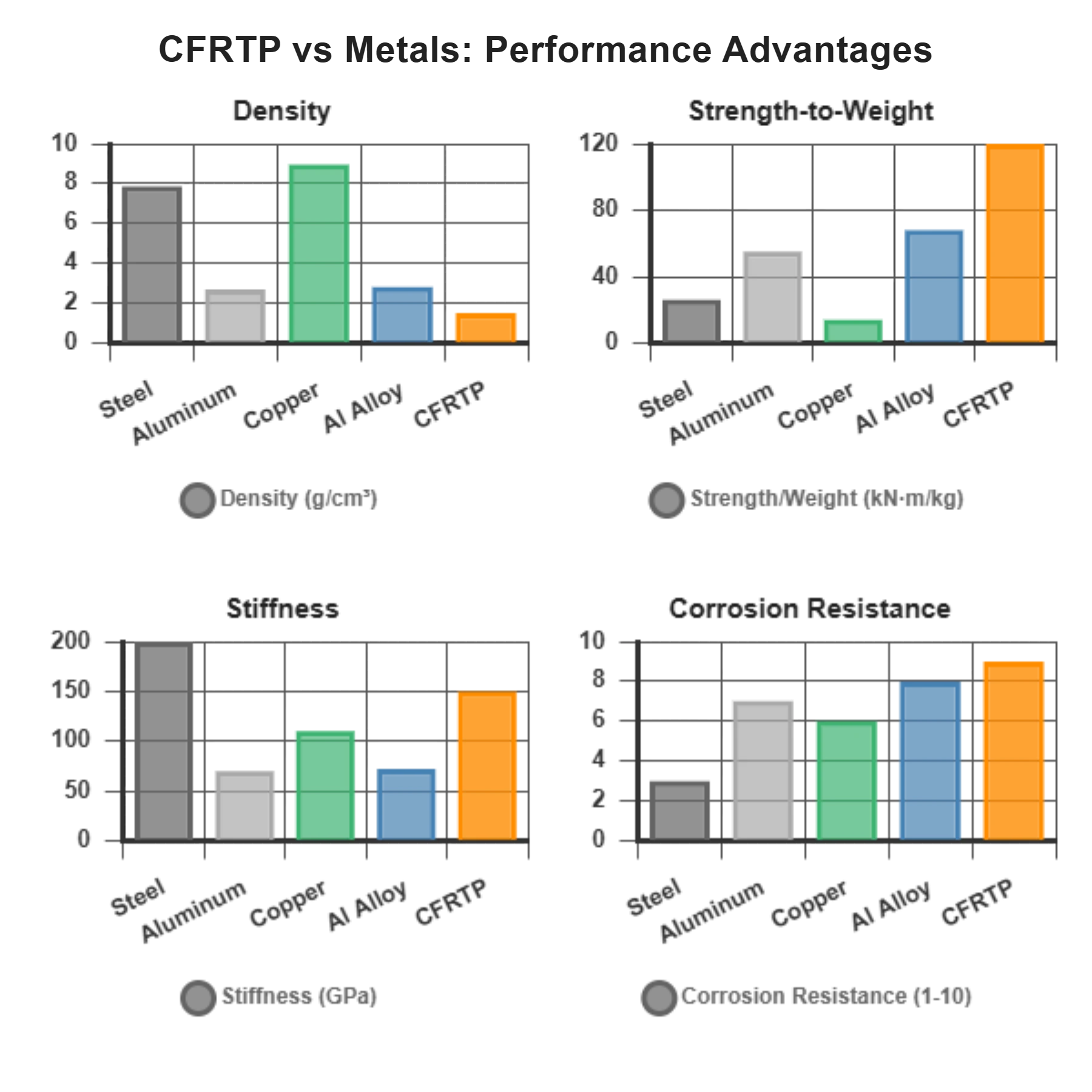
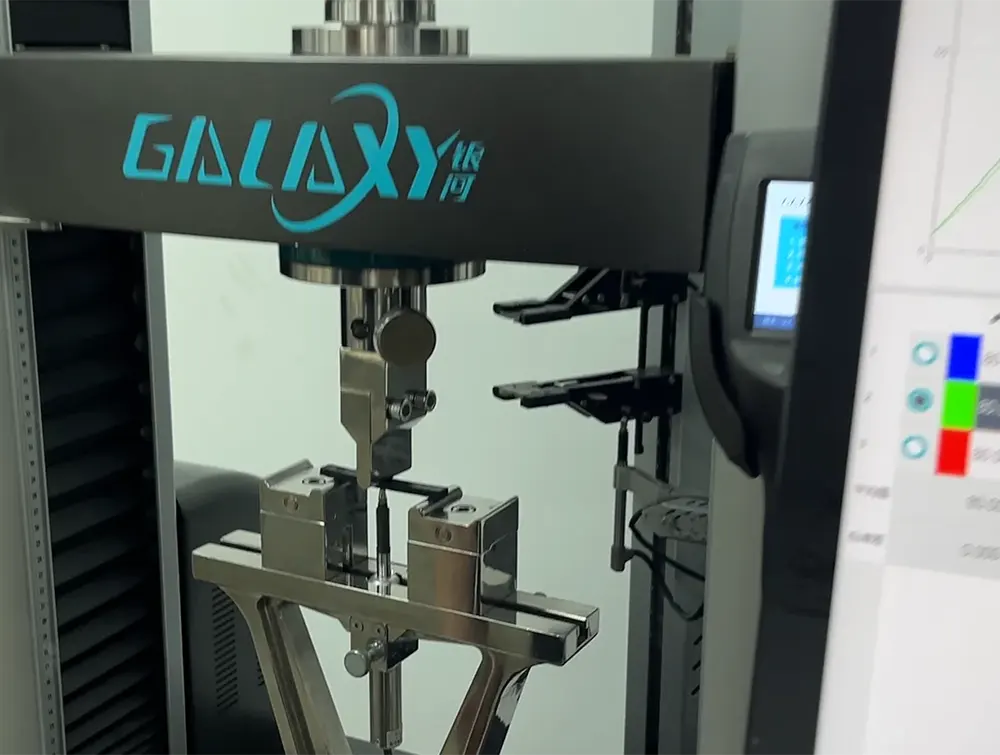

Frequently Asked Questions
Carbon (Xiamen) New Material Co., Ltd. aims to provide buyers with "one-stop" worry-free high-quality services. Here you can find all information about carbon fiber engineering plastics. If you still have questions, please send us an email for consultation!
-
How can I contact the manufacturer of a product that interests me?
When you find a product you are interested in, you can contact the manufacturer directly by sending an email and we will get back to you as soon as possible.
-
How do I find the products that interest me?
All you need to do is enter the keyword, product name in the search window and press the Enter key on your keyboard. Your search results page will then be displayed. You can also search within the product category pages on the home page. Each category is divided into subcategories, allowing you to refine your search and find products that interest you.
-
Where will I find a buying guide?
Please contact our after-sales service directly and we will provide you with a comprehensive operating guide.
-
What are CF Reinforced Thermoplastic Composites?
CF Reinforced Thermoplastic Composites are materials where carbon fibers are incorporated into a thermoplastic matrix. They combine the strength and stiffness of carbon fibers with the processability and recyclability of thermoplastics. For instance, they are used in automotive parts like bumper beams.
-
What are the benefits of CF Reinforced Thermoplastic Composites over traditional composites?
The key benefits include faster production cycles, easier recyclability, and better impact resistance. They also offer design flexibility. An example is in the manufacturing of consumer electronics casings where complex shapes can be achieved more easily.
-
How are CF Reinforced Thermoplastic Composites processed?
Common processing methods include injection molding, extrusion, and compression molding. Injection molding is widely used for mass production. For example, in the production of small components for the medical industry.
-
What industries use CF Reinforced Thermoplastic Composites?
They are utilized in aerospace, automotive, medical, and sports equipment industries. In aerospace, they can be found in interior components. In the medical field, they might be used in prosthetics.
-
How does the carbon fiber content affect the properties of the composites?
Higher carbon fiber content generally leads to increased strength and stiffness but may reduce ductility. A moderate content is often balanced for specific applications. For example, a higher content might be preferred in structural parts of a race car.
-
What are the challenges in using CF Reinforced Thermoplastic Composites?
Challenges include higher material costs, complex processing equipment requirements, and ensuring uniform fiber dispersion. Issues with adhesion between the fibers and the matrix can also arise. An example is in achieving consistent quality in large-scale production.







